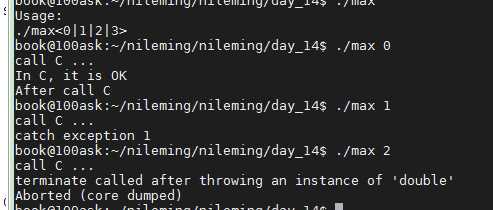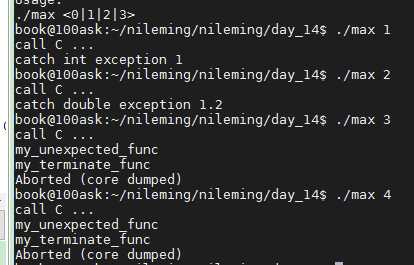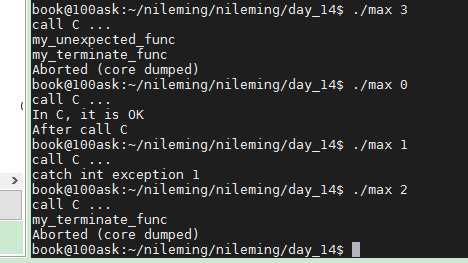标签:设置 other cal exce closed float his src lap
一句话概括:捕获异常:
谁捕获异常?
捕捉谁?---------------------A捕捉B--------------------------A()
{
try{
B();
}
C();
}
谁制造了异常?-----------函数B-----------------------------B()
{
throw 某个对象:
}
捕获后怎么处理?-------------随A怎么做-------------------A()
{
try{
B();
} catch(类形 对象)
{
//处理
}
}

1 #include <iostream> 2 #include <string.h> 3 #include <unistd.h> 4 5 using namespace std; 6 7 void C () 8 { 9 throw 1; 10 } 11 12 void B () 13 { 14 C(); 15 } 16 void A() 17 { 18 try { 19 B(); 20 }catch (int i) 21 { 22 cout<<"catch exception"<<i<<endl; 23 } 24 } 25 int main(int argc,char**argv) 26 { 27 A(); 28 return 0; 29 }
运行结果:

函数B可能抛出多种异常---------------------{1)函数A中可有多个catch分支
2)catch分支中,对于异常对象,先捕获派生类对象,再捕获基类对象,按此顺序排放代码
3)未能捕获的异常,将继续抛给上一层的调用者}

1 #include <iostream> 2 #include <string.h> 3 #include <unistd.h> 4 #include <stdlib.h> 5 6 using namespace std; 7 8 void C (int i) 9 { 10 int a = 1; 11 double b = 1.2; 12 float c = 1.3; 13 if (i == 0) 14 { 15 cout<<"In C, it is OK"<<endl; 16 } 17 else if(i == 1) 18 { 19 throw a; 20 } 21 else if(i == 2) 22 { 23 throw b; 24 } 25 else 26 { 27 throw c; 28 } 29 } 30 31 void B (int i) 32 { 33 cout<<"call C ..."<<endl; 34 C(i); 35 cout<<"After call C"<<endl; 36 } 37 void A(int i) 38 { 39 try { 40 B(i); 41 }catch (int j)//只可以捕捉int型的变量,其他的就会使用磨人的 42 { 43 cout<<"catch exception "<<j<<endl; 44 } 45 } 46 int main(int argc,char**argv) 47 { 48 int i; 49 if (argc != 2) 50 { 51 cout<<"Usage: "<<endl; 52 cout<<argv[0]<<"<0|1|2|3>"<<endl; 53 return -1; 54 } 55 i = strtoul(argv[1],NULL,0); 56 A(i); 57 return 0; 58 }
运行结果:


1 #include <iostream> 2 #include <string.h> 3 #include <unistd.h> 4 #include <stdlib.h> 5 6 using namespace std; 7 8 void C (int i) 9 { 10 int a = 1; 11 double b = 1.2; 12 float c = 1.3; 13 if (i == 0) 14 { 15 cout<<"In C, it is OK"<<endl; 16 } 17 else if(i == 1) 18 { 19 throw a; 20 } 21 else if(i == 2) 22 { 23 throw b; 24 } 25 else 26 { 27 throw c; 28 } 29 } 30 31 void B (int i) 32 { 33 cout<<"call C ..."<<endl; 34 C(i); 35 cout<<"After call C"<<endl; 36 } 37 void A(int i) 38 { 39 try { 40 B(i); 41 }catch (int j)//只可以捕捉int型的变量,其他的就会使用磨人的 42 { 43 cout<<"catch exception "<<j<<endl; 44 }catch(double b) 45 { 46 cout<<"catch double exception"<<b<<endl; 47 }catch(...)//解决了其他情况的时候 48 { 49 cout<<"catch other exception"<<endl; 50 } 51 52 } 53 int main(int argc,char**argv) 54 { 55 int i; 56 if (argc != 2) 57 { 58 cout<<"Usage: "<<endl; 59 cout<<argv[0]<<"<0|1|2|3>"<<endl; 60 return -1; 61 } 62 i = strtoul(argv[1],NULL,0); 63 A(i); 64 return 0; 65 }

1 #include <iostream> 2 #include <string.h> 3 #include <unistd.h> 4 #include <stdlib.h> 5 6 using namespace std; 7 8 class MyExveption{ 9 public: 10 void what(void){ 11 cout <<"This is MyException"<<endl; 12 } 13 14 }; 15 16 void C (int i) 17 { 18 int a = 1; 19 double b = 1.2; 20 float c = 1.3; 21 if (i == 0) 22 { 23 cout<<"In C, it is OK"<<endl; 24 } 25 else if(i == 1) 26 { 27 throw a; 28 } 29 else if(i == 2) 30 { 31 throw b; 32 } 33 else if(i == 4) 34 { 35 throw MyExveption();//扔出一个对象 36 } 37 else 38 { 39 throw c; 40 } 41 } 42 43 void B (int i) 44 { 45 cout<<"call C ..."<<endl; 46 C(i); 47 cout<<"After call C"<<endl; 48 } 49 void A(int i) 50 { 51 try { 52 B(i); 53 }catch (int j)//只可以捕捉int型的变量,其他的就会使用磨人的 54 { 55 cout<<"catch exception "<<j<<endl; 56 }catch(double b) 57 { 58 cout<<"catch double exception"<<b<<endl; 59 }catch(MyExveption &e) 60 { 61 e.what(); 62 }catch(...)//解决了其他情况的时候 63 { 64 cout<<"catch other exception"<<endl; 65 } 66 67 } 68 int main(int argc,char**argv) 69 { 70 int i; 71 if (argc != 2) 72 { 73 cout<<"Usage: "<<endl; 74 cout<<argv[0]<<"<0|1|2|3>"<<endl; 75 return -1; 76 } 77 i = strtoul(argv[1],NULL,0); 78 A(i); 79 return 0; 80 }
上述代码抛出中有对象
基类函数中没有实现多态:

1 #include <iostream> 2 #include <string.h> 3 #include <unistd.h> 4 #include <stdlib.h> 5 6 using namespace std; 7 8 class MyException { 9 public: 10 void what(void) { cout<<"This is MyException"<<endl; } 11 }; 12 13 class MySubException : public MyException{ 14 public: 15 void what(void) { cout<<"This is MySubException"<<endl; } 16 }; 17 18 19 void C(int i) 20 { 21 int a = 1; 22 double b= 1.2; 23 float c = 1.3; 24 25 if (i == 0) 26 { 27 cout<<"In C, it is OK"<<endl; 28 } 29 else if (i == 1) 30 throw a; 31 else if (i == 2) 32 throw b; 33 else if (i == 3) 34 throw c; 35 else if (i == 4) 36 throw MyException(); 37 else if (i == 5) 38 throw MySubException(); 39 } 40 41 void B(int i) 42 { 43 cout<<"call C ..."<<endl; 44 C(i); 45 cout<<"After call C"<<endl; 46 } 47 48 void A(int i) 49 { 50 try { 51 B(i); 52 } catch (int j) 53 { 54 cout<<"catch int exception "<<j<<endl; 55 } catch (double d) 56 { 57 cout<<"catch double exception "<<d<<endl; 58 } catch (MyException &e)//由于基类没有实现多态所以只会使用基类的函数 59 { 60 e.what(); 61 } catch (...){ 62 cout<<"catch other exception "<<endl; 63 } 64 } 65 66 67 int main(int argc, char **argv) 68 { 69 int i; 70 if (argc != 2) 71 { 72 cout<<"Usage: "<<endl; 73 cout<<argv[0]<<" <0|1|2|3>"<<endl; 74 return -1; 75 } 76 77 i = strtoul(argv[1], NULL, 0); 78 79 A(i); 80 81 return 0; 82 }
运行结果:

基类中实现多态:

1 #include <iostream> 2 #include <string.h> 3 #include <unistd.h> 4 #include <stdlib.h> 5 6 using namespace std; 7 8 class MyException { 9 public: 10 virtual void what(void) { cout<<"This is MyException"<<endl; }//实现多态 11 }; 12 13 class MySubException : public MyException{ 14 public: 15 void what(void) { cout<<"This is MySubException"<<endl; } 16 }; 17 18 19 void C(int i) 20 { 21 int a = 1; 22 double b= 1.2; 23 float c = 1.3; 24 25 if (i == 0) 26 { 27 cout<<"In C, it is OK"<<endl; 28 } 29 else if (i == 1) 30 throw a; 31 else if (i == 2) 32 throw b; 33 else if (i == 3) 34 throw c; 35 else if (i == 4) 36 throw MyException(); 37 else if (i == 5) 38 throw MySubException(); 39 } 40 41 void B(int i) 42 { 43 cout<<"call C ..."<<endl; 44 C(i); 45 cout<<"After call C"<<endl; 46 } 47 48 void A(int i) 49 { 50 try { 51 B(i); 52 } catch (int j) 53 { 54 cout<<"catch int exception "<<j<<endl; 55 } catch (double d) 56 { 57 cout<<"catch double exception "<<d<<endl; 58 } catch (MyException &e)//由于基类没有实现多态所以只会使用基类的函数 59 { 60 e.what(); 61 } catch (...){ 62 cout<<"catch other exception "<<endl; 63 } 64 } 65 66 67 int main(int argc, char **argv) 68 { 69 int i; 70 if (argc != 2) 71 { 72 cout<<"Usage: "<<endl; 73 cout<<argv[0]<<" <0|1|2|3>"<<endl; 74 return -1; 75 } 76 77 i = strtoul(argv[1], NULL, 0); 78 79 A(i); 80 81 return 0; 82 }
运行结果:

函数B可以声明异常
void B(void) thow (int, double, MyException){ ... } //会抛出int,double,MyException类异常
void B(void) thow (){ ... } //不会会抛出任何异常
void B(void) { ... } //可能抛出任何异常
可以事先设置处理函数
想知道函数B会抛出什么异常-----------------------------如果抛出了意外的异常
对于意料之外的异常,会执行2个函数:
"unexpected"函数(可以自己提供),
"terminate"函数(可以自己提供)
"unexpected"函数用来处理声明之外的异常
"terminate"函数用来处理"catch分支未捉到异常"

1 #include <iostream> 2 #include <string.h> 3 #include <unistd.h> 4 #include <stdlib.h> 5 6 using namespace std; 7 8 class MyException { 9 public: 10 virtual void what(void) { cout<<"This is MyException"<<endl; } 11 }; 12 13 class MySubException : public MyException{ 14 public: 15 void what(void) { cout<<"This is MySubException"<<endl; } 16 }; 17 18 19 void C(int i) throw(int, double) 20 { 21 int a = 1; 22 double b= 1.2; 23 float c = 1.3; 24 25 if (i == 0) 26 { 27 cout<<"In C, it is OK"<<endl; 28 } 29 else if (i == 1) 30 throw a; 31 else if (i == 2) 32 throw b; 33 else if (i == 3) 34 throw c; 35 else if (i == 4) 36 throw MyException(); 37 else if (i == 5) 38 throw MySubException(); 39 } 40 41 void B(int i) 42 { 43 cout<<"call C ..."<<endl; 44 C(i); 45 cout<<"After call C"<<endl; 46 } 47 48 void A(int i) 49 { 50 try { 51 B(i); 52 } catch (int j) 53 { 54 cout<<"catch int exception "<<j<<endl; 55 } catch (double d) 56 { 57 cout<<"catch double exception "<<d<<endl; 58 } catch (MyException &e) 59 { 60 e.what(); 61 } catch (...){ 62 cout<<"catch other exception "<<endl; 63 } 64 } 65 #if 1 66 void my_unexpected_func() 67 { 68 cout<<"my_unexpected_func"<<endl; 69 } 70 71 72 void my_terminate_func () { cout<<"my_terminate_func"<<endl; } 73 74 #endif 75 int main(int argc, char **argv) 76 { 77 int i; 78 79 set_unexpected (my_unexpected_func); 80 set_terminate(my_terminate_func); 81 82 if (argc != 2) 83 { 84 cout<<"Usage: "<<endl; 85 cout<<argv[0]<<" <0|1|2|3>"<<endl; 86 return -1; 87 } 88 89 i = strtoul(argv[1], NULL, 0); 90 91 A(i); 92 93 return 0; 94 }
运行结果:


1 #include <iostream> 2 #include <string.h> 3 #include <unistd.h> 4 #include <stdlib.h> 5 6 using namespace std; 7 8 class MyException { 9 public: 10 virtual void what(void) { cout<<"This is MyException"<<endl; } 11 }; 12 13 class MySubException : public MyException{ 14 public: 15 void what(void) { cout<<"This is MySubException"<<endl; } 16 }; 17 18 19 void C(int i) throw(int, double) 20 { 21 int a = 1; 22 double b= 1.2; 23 float c = 1.3; 24 25 if (i == 0) 26 { 27 cout<<"In C, it is OK"<<endl; 28 } 29 else if (i == 1) 30 throw a; 31 else if (i == 2) 32 throw b; 33 else if (i == 3) 34 throw c; 35 else if (i == 4) 36 throw MyException(); 37 else if (i == 5) 38 throw MySubException(); 39 } 40 41 void B(int i) 42 { 43 cout<<"call C ..."<<endl; 44 C(i); 45 cout<<"After call C"<<endl; 46 } 47 48 void A(int i) 49 { 50 try { 51 B(i); 52 } catch (int j) 53 { 54 cout<<"catch int exception "<<j<<endl; 55 } catch (MyException &e) 56 { 57 e.what(); 58 } 59 } 60 61 void my_unexpected_func() 62 { 63 cout<<"my_unexpected_func"<<endl; 64 } 65 66 void my_terminate_func () { cout<<"my_terminate_func"<<endl; } 67 68 69 int main(int argc, char **argv) 70 { 71 int i; 72 73 set_unexpected (my_unexpected_func); 74 set_terminate(my_terminate_func); 75 76 if (argc != 2) 77 { 78 cout<<"Usage: "<<endl; 79 cout<<argv[0]<<" <0|1|2|3>"<<endl; 80 return -1; 81 } 82 83 i = strtoul(argv[1], NULL, 0); 84 85 A(i); 86 87 return 0; 88 }
上述代码用来验证:
"unexpected"函数用来处理声明之外的异常
"terminate"函数用来处理"catch分支未捉到异常"
运行结果:

标签:设置 other cal exce closed float his src lap
原文地址:https://www.cnblogs.com/yekongdebeijixing/p/12189719.html